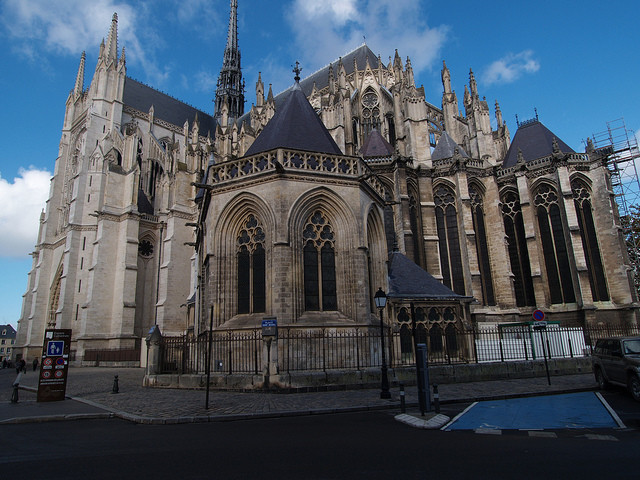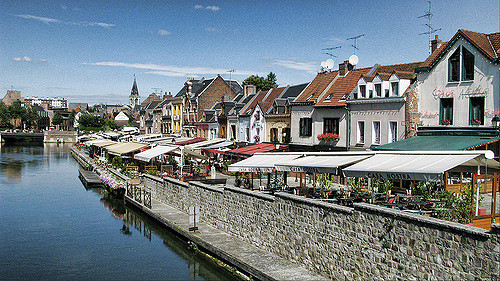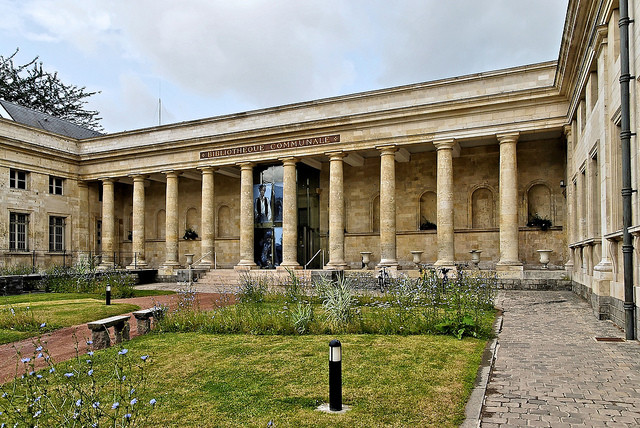History of the city
Amiens can be found in the northern part of France; it is the capital of the Somme department in the region of Picardy, or Picardie in French. Despite being a small town, it is very well-known for its famous cathedral: the Notre Dame ´Amiens, or, in English it translates to "Our Lady of Amiens". This is the largest Gothic cathedral in France, with it being forty meters high.

Another charming aspect of the city is that the river Somme cuts through it, and we can appreciate this especially in the neighbourhood of Saint Leu, for example. There is no need to worry about the river, as it has calm waters with few floods.
Another aspect that stands out in Amiens is the famous Hortillonnages D'Amiens, from which the city developed due to the slope of Saint Pierre. We can still see this slope today. Even so, the city was built on the slope and the well-known street of Saint Pierre was on a little bit of a hill. This was the northern exit of the city.

During the Middle Ages, a network of canals was built that allowed bridges and buildings to be built.
The Somme River Canal was created at the beginning of the 19th century, but the bridge at the foot of the city was not built until the end of the Second World War. For this reason, the most developed part of the city, in all aspects, has always been the surroundings of Saint Leu.
Another outstanding aspect of the city is its geographical location within France. This makes it a strategic place in terms of communications because it connects Paris and Lille, Normandy and Benelux, France with England, France with Germany, or France with Belgium.
In its beginnings, the city was called Samarobriva, which means "bridge over the Somme" and, for the first time in history, it was named in the 5th book of the Gallic War in the year 54BC.

The book recounts that Julius Caesar spent some time between 54 and 53BC with his soldiers in battles against the Belgians.
As I said before, the geographical location of Amiens made the city into a strategic stronghold to win battles and as a passage to the routes to northern France, and so it became the center of the Roman camp.
We do not know exactly where the Celtic colonies settled, but we do know the exact place where the Roman colonies settled, due to the characteristics of the place, since it was a perfectly geometric area, with intertwined streets always forming right angles.
We can distinguish two phases within the construction of the city: firstly, there was the one in the northern zone formed by twenty big blocks of housing. This made 160 meters of length and 125 meters of width, constructed in 40 hectares. Like any Roman settlement, there must have been an Amphitheatre, which in this case was located in the western part of the city.
The second phase began in the 2nd century after Christ, and deals with an extension of the blocks of housing. Now they are larger, about 160 meters long by 160 meters wide on a land of about 105 hectares.
After the Second World War, the remains of the Amphitheatre, a group of thermal baths and a forum were found, but no remains are preserved today. With the German invasion in 256, the city was destroyed and completely devastated, since it had no defence or protection at that time. From then on, part of the city was rebuilt and walls were built around the city. In order to save money, the walls were built with the materials that had been left over from the destruction of buildings, sculptures and the obituaries of cemeteries that had been abandoned.
Today we know the exact date on which the wall was built, thanks to a coin of Emperor Probus in the years 277-278 which were found in 1951.

We know that to get out of the city there were three gates:
The "clippianaque" gate to the south of the city, which we know about thanks to Bishop San Fermín de Amiens, the first bishop of Amiens who was beheaded in 303. This bishop was in charge of converting the citizens of Amiens to Christianity.
Another of the gates was in the east, in the old church of San Martín. Martin was an officer in charge of the Roman troops. Legend has it that on a winter night in 338 he gave his cape to a poor man who was cold.
The last door faced the Somme river in case they had to escape through the river in the event of an attack.
Amiano Marcelino describes Amiens as one of the most important cities in the Belgian Gaul, with great economic, administrative and military activity. There are no remains to corroborate it, but there are books describing the city with an arms factory, barracks for the troops and workshops where they made military uniforms.
After the death of Bishop San Fermín, Amiens became a permanent bishopric. Eulogius was the first bishop who can testify historically.

The war between France and Great Britain ended with the peace treaty called the "Treaty of Amiens" on March 25, 1802. Unfortunately, the treaty did not make anything very clear, so a year later they returned to war again.
Throughout its history, Amiens has known many important people for many different reasons; painters, philosophers, writers... Let me tell you about the most outstanding ones:
- Clovis Trouille (1889 - 1975). Trouille was a painter born in Paris. His main works of art can be admired in the Picardy Museum in Amiens.
- Peter the Hermit (unknown - 1115). He was also known as Pedro de Amiens; he was a priest and religious leader for the well known group of pilgrims called the "People's Crusade", who wanted to arrive at the Holy Land.
- Charles de Bovelles (1470 - 1567). This man was a philosopher and mathematician and creator of Noyon. His "Géométrie en Françoys" (1511) was the first scientific work to be printed in French.
- Pierre Choderlose de Laclos (1741 - 1803). Soldier and writer, he is the author of "Dangerous Friendships". Over the years he was considered to be a bit of a scandalous writer.
- Jules Verne (1828 - 1905). A very famous writer who died in Amiens and wrote adventure and science fiction novels such as "Journey to the Centre of the Earth" or "Twenty Thousand Leagues of Underwater Journey".
- Édouard Branly (1844 - 1940). Branly was a physicist, teacher and inventor who participated in inventions such as the wireless telegraph.
- Roland Dorgelès (1885 - 1973). Born in Amiens, he was a journalist and writer, author of novels such as "The Machine to End War".
- Auguste Perret (1874 - 1945). Famous French architect whose name is still present in Amiens, thanks to the "Tour Perret".
- Maurice Boitel (1919 - 2007). French painter who studied at the Ecole des Beaux-Arts in Paris and won almost all of the French painting awards.
- Nicolás Barré (1621 - 1686). Born in Amiens, he was a religious lay brother.
- Bruno Lebel (born 1933). 80 years old, he has been a very famous French sculptor who won many sculpture awards.
Photo gallery
Content available in other languages
- Español: Historia de la ciudad
- Français: Histoire de la ville d'Amiens
- Italiano: Amiens: storia della città.
Want to have your own Erasmus blog?
If you are experiencing living abroad, you're an avid traveller or want to promote the city where you live... create your own blog and share your adventures!
I want to create my Erasmus blog! →





















Comments (0 comments)